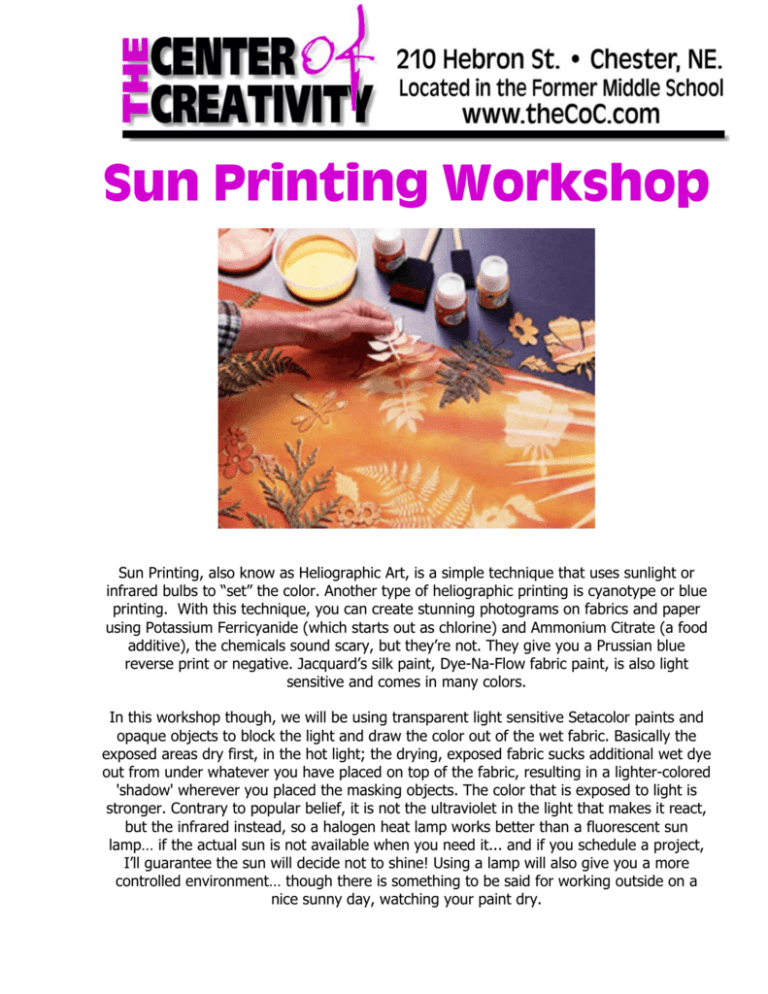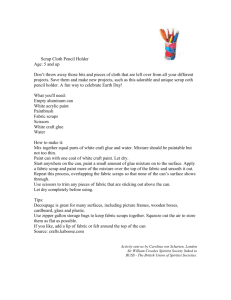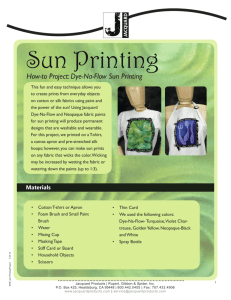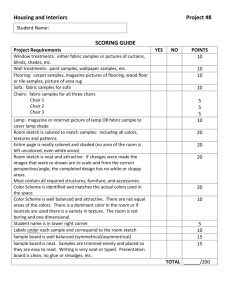Sun Printing Workshop - The Center of Creativity
advertisement

Sun Printing Workshop Sun Printing, also know as Heliographic Art, is a simple technique that uses sunlight or infrared bulbs to “set” the color. Another type of heliographic printing is cyanotype or blue printing. With this technique, you can create stunning photograms on fabrics and paper using Potassium Ferricyanide (which starts out as chlorine) and Ammonium Citrate (a food additive), the chemicals sound scary, but they’re not. They give you a Prussian blue reverse print or negative. Jacquard’s silk paint, Dye-Na-Flow fabric paint, is also light sensitive and comes in many colors. In this workshop though, we will be using transparent light sensitive Setacolor paints and opaque objects to block the light and draw the color out of the wet fabric. Basically the exposed areas dry first, in the hot light; the drying, exposed fabric sucks additional wet dye out from under whatever you have placed on top of the fabric, resulting in a lighter-colored 'shadow' wherever you placed the masking objects. The color that is exposed to light is stronger. Contrary to popular belief, it is not the ultraviolet in the light that makes it react, but the infrared instead, so a halogen heat lamp works better than a fluorescent sun lamp… if the actual sun is not available when you need it... and if you schedule a project, I’ll guarantee the sun will decide not to shine! Using a lamp will also give you a more controlled environment… though there is something to be said for working outside on a nice sunny day, watching your paint dry. The Basics This is a very simple process and it’s almost impossible to make a mistake if you follow some basic guidelines. 1. Pre-washing your fabric - ideally with a professional dyer's product called Dharma Professional Textile Detergent and/or an enzyme detergent. This removes most oils, sizing, and pre-shrinks the fabric allowing the dyes will adhere better. It also gets out excess dye better and faster than normal household detergents so that items are safe to wash with others in the future and is non-toxic and has no fumes. Regular detergent will work well too, if you aren’t working on a critical piece. 2. Preparing your workspace – You will need a board that is a little bigger than your fabric that you plan to work on so that you can move it easily to your light source, this can be a piece of plywood or a flat cardboard. You will need to cover the board with plastic, a garbage bag tighten around it and held with some duct tape would be perfect, the wet fabric will stick to the plastic and hold it in place while you work on your piece. If you are making a tote bag or t-shirt, you’ll want a board covered in plastic that fits snuggly inside so that you don’t get paint on the wrong side of your work. If you are planning to paint both sides of your piece, do one side completely then the other. You can only “set” one side at a time so you don’t want to put wet paint on both, at the same time, you’ll have a mess. 3. Finding your masking objects – You should have a variety of masking object at hand before you start putting wet color down. These can be anything, though flat things work the best. 3 dimensional objects allow the light to creep around the edges and will give you a soft or blurred edge. The flatter the object and the tighter it lays on the painted surface, the crisper the outline will be. You can also achieve reverse images by using painting stencils. Clear plastic pieces or shapes will work as a mask as well. The short list of some items might be and is not limited to… • Leaves • Branches • Paper Cutouts • Silk Plants • Bottle Caps • Wire Mesh • String • Feathers • Foam Shapes • Nuts and Bolts • Pieces of Metal • • Tools from the Garage • Sewing Notions • Stuff from your Junk Drawer • • Anything with an Interesting Shape or Pattern• Basically, you just need to get creative… 4. Preparing your paints – We are using transparent Setacolor Fabric Paint for this project but the others are basically the same. You can use it straight out of the bottle for more vibrant color or mix it 2 parts water to 1 part paint, which is still pretty vibrant. Your fabric is going to be wet so you don’t want to dilute it any more than that. Make sure that you prepare plenty ahead of time, but keep in mind that a little paint goes a long way, you’ll be surprised. We use ice trays to hold our paint while we are working, you can easily separate the colors and still have room for mixing on the fly. It’s just really time consuming to put it back in the bottle if you don’t want to throw it away. Or, you can use disposable bowls. 5. Applying paint – Now you have everything ready to start… Take your board, covered in plastic, and secure your fabric to it. Then you apply water to the fabric, either by painting it on with a brush (foam brushes work great for this) or spray it on using a spray bottle. Once wet it will stick to the smooth, waterproof surface of your board. If you do have trouble with it moving, you can use straight pens to hold it in place (though they might leave a small light marks in your final piece, depending on your light source when you expose it). Apply your predominant color first, leaving room to work in your other colors. To get a smoother blend between your colors, make sure that your fabric is fairly wet (but not dripping!). For less blend and stronger color, use less water and keep your paint strokes about ½ an inch away from each other, they will bleed together. If you use too many different colors, you might end up with “mud” as the colors mix. Ideally, 2 or 3 colors blend nicely. Once you have the entire piece painted with color (where there is no paint, there will be no image.), it’s time to start laying out your design. 6. Laying it out – You’ll want to quickly arrange your design on the wet fabric because you don’t want it to dry on you. Press each item down so that it lays flat against the surface. This will give you a nice sharp edge. If you will be exposing the piece outside in the sun, make sure that you secure the masking objects so that they don’t blow away. You can pin them in place or use stones to hold the pieces down, though they might leave a small mark on your finished piece so be careful of your placement. Another option is to put a large screen over the whole thing, which will give you an interesting effect that you can incorporate into your piece. At this point, you can also apply coarse salt to the fabric to get star bursts, only a few grains are needed. The finer the salt the finer the effect, larger granules will give you more dramatic star bursts as the salt pieces push the color away from themselves. You can use any kind of household salt (We use coarse sea salt) and there are commercial salts available as well. To apply it, you just sprinkle it where you want it or throw it on randomly. If you don’t get an effect, your cloth is too wet. 7. Setting the color – You have your piece mounted on a board, it is wet with a beautiful blend of color, you have carefully (or not so carefully) placed your masking objects on it and are now ready to set the color. It’s a gorgeous sunny summer day outside so you pick it up and set it in a hot sunny spot… OR, and more likely the case, it’s raining and overcast so you take it over to the table that you have your heat lamp set-up on and place it evenly under the light. How long this takes depends on a few factors, like how wet is your fabric? How hot is your light source? How badly do you want it to dry? Be assured, it will dry slower if you are watching it. So, go make another one! Checking back every so often to see how it’s doing, you can do this by peeking under the corner of one of your mask object (do this carefully as not to move it out of position), it will look lighter. It could take anywhere from 10 minutes to an hour to dry. Once it is dry, it has stopped doing its thing; you can take everything off of it now and admire your new creation… as you head over to your ironing station where you are going to flip it over and iron the reverse side for 2 or 3 minutes, on the hottest setting. Once you have set the color with heat, you need to wait 24 hours before you wash it, after you have finished your creation it can be machine washable and also dry-cleaned. Here is a comparison of how different objects react to exposure. I used white 100% cotton for this sample. Every material reacts differently but 100% cotton and silk works the best, you will get mixed results on canvas. Also, the more water you use, the lighter the color will be. Another thing to watch out for is not to get your light source too close, you don’t want to dry your fabric too fast or the image won’t develop. And if you get it too hot, some of your objects will melt. Techniques & Materials- We recommend starting simple! The basic supplies that you will need are the dye or paint, some fabric or clothing/accessory to paint on, and some brushes, sponges, or stamps to apply your color with. Working with fabric paints, rather than dyes, is a good place for beginners to start. A nice fabric to practice on would be the Cotton Print Cloth or some bleached muslin; a great first project might be decorating a T-Shirt, painting a scarf, or stamping on a tote bag. Wonderful pieces can be created with simply a paintbrush and a jar of paint but you may want to explore some other ways of patterning and coloring your fabric. Batiking is a technique where melted wax is applied with a brush or applicator on fabric to act as a resist to the dyes or paints that are applied after the wax. The dyes or paints seep into the cracked wax resulting in beautiful crackled effects. Silk Painting is a technique where dyes or paints are applied to stretched silk, often after guttas or resists have been applied. Beautiful water-color-like effects can be achieved and enhanced with sprinkled salt, watermarks and alcohol. Marbling is a technique where paints are dropped onto a prepared bath that allows the colors to float on the surface. The colors are moved around into swirls and patterns and then the fabric is laid onto the surface of the bath to pick up the patterns. Stamping is a printing technique and involves applying paint to a carved or cut shape and impressing the image onto a surface. Silk Screening is a printing technique using a fine mesh screen held in a wooden frame. Ink or resist is pressed through a stencil on the screen mesh using a squeegee to print onto the fabric. Sun Printing is a technique done with Setacolor or Dye-Na-Flow paints where a wash of diluted paints is applied to fabric, an object (leaf, lace, etc.) is placed on top of the wet paint, and the piece is placed in direct sunlight or under a lamp. When dry, the object is removed and the area underneath will be white! Tie Dyeing is a resist technique where fabric is tied with cord or bands before dye or paint is applied. The banded areas resist the color, resulting in interesting patterns. Salting is the use of salts or sugars to create brilliant bursts of color in the dye or paint. It is sprinkled onto wet dye and acts as a drying agent, to pull the color to each granule. The finer the salt the finer the detail, the coarser the salt the larger the effect. Coarse Sea Salt, Kosher Salt, or Rock Salt works very well for this. Sugar offers a less dramatic effect than salt, but can be used. Rubbing Alcohol will wick into the fabric when used with water; creating a soft puddle shaped texture with a darker edge. It can be applied by dripping, spraying, or painting. Sun Printing Linkshttp://www.dharmatrading.com/ For complete instructions on a variety of techniques and everything else you will need for producing them, including silk scarves and cotton tote bags. http://www.misterart.com/ Mister Art offers a large variety of reasonably priced supplies, including silk scarves and cotton tote bags. http://www.dickblick.com/ Dick Blick, art materials offers a large variety of reasonably priced supplies. http://www.prochemicalanddye.com Pro Chemical & Dye has everything that you could ever want or need to sun print with. http://cheaptotes.com/ Cheap Totes is a great source for tote bags of all shapes and sizes. http://www.jillkennedy.com/ Jill Kennedy is a textile artist from the UK. There are several of her videos on YouTube and she offers DVD’s and online courses for sale. www.TheCoC.com The Center of Creativity has a list of Amazon books and links to many other useful things, as well as an updated workshop schedule with online payment and other “How To” information. (While there, don’t forget to click on the sponsor ads) http://www.handworkhandcraft.com/ Hand Work, Hand Craft. There are several really good articles on technique here.






